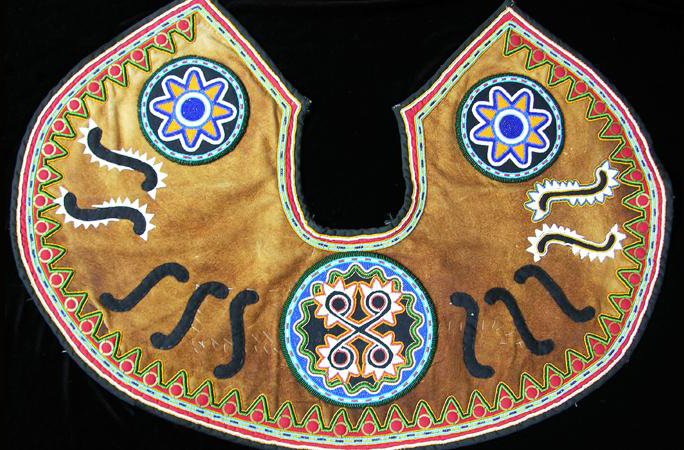McKissick Museum exhibition features artwork from 25 Native American tribal nations

From The State:
Image: Roger Amerman, Choctaw frontier jacket
A trail-blazing, year-long exhibit of more than a dozen different kinds of Native American artwork in Southeastern states opens Friday, Aug. 8, at the McKissick Museum on the University of South Carolina campus.
With some 150 pieces of art, curators said that never before have so many different Native American art forms from across the Southeast been exhibited at the university.
“This exhibit probably has the most objects, as well as more diversity than any other show we’ve done since I’ve been here,” said Saddler Taylor, the museum’s curator of folklife, who has been with McKissick since 2001 and overseen dozens of exhibits.
“We’ve done pottery shows, and basketry shows, but this one is just chock full of a wide variety of objects that represent a lot of different traditions from a lot of different culture groups.” Taylor said.
The exhibition kicks off a list of events throughout the year at USC on Native American art, music and history.
Items on exhibit in “Traditions, Change & Celebration: Native Artists of the Southeast” include men’s and women’s clothing, pottery, baskets, quilts, textiles, stickball rackets and wampum belts that use images and symbols to tell stories. Also included are musical instruments such as drums and rattles, dolls, beadwork and stone, shell and wood carvings. Two television screens will feature story-telling and images of live music performances.
The objects come from more than 40 Native American artists from 25 tribal nations and cultures in nine different states, from Virginia to Florida, and west to Texas.
“It’s not just South Carolina,” Taylor said.
Tribes and groups represented include the Catawbas, Cherokees, Creeks, Seminole, Lumbees and Chickasaws. Museums furnishing items from their collections include the North Carolina Museum of History, the Tom Blumer Collection at USC Lancaster and museums in Louisiana, Alabama, Florida, Texas and Virginia.
Lynette Allston, a potter and chief of the Virginia Nottoway Indians, is one of the Native Americans who is exhibiting at the show.
“Having an exhibit like this, it’s an opportunity to express a part of your ancestry, your heritage, that normally is not highlighted,” Allston said.
The varied art forms in the show are ones practiced by original Native Americans, but some contemporary elements can be found in many exhibits, she said. For example, she uses glaze on her pottery, when the first Americans did not.
Curators gave Will Goins, a Columbia resident, artist and chief executive of the Cherokees, credit for contacting and getting the 150 pieces from artists, private collections and museums in the nine states. He is chief of the Eastern Cherokee Southern Iroquois and United Tribes of South Carolina.
For years, the 52-year-old Goins – a beadwork artist and story teller whose work is also in the show – had worked with many other artists and tribes, so he had the personal connections and credibility across the South to efficiently get the material, curators said.
It took him a year to plan the show and gather all the items, working on it every day, Goins said. McKissick had so few Native American pieces in its collections that nearly all the show’s items came from elsewhere, he said.
One exhibit Goins especially likes is a concept he calls “Artist as Leader” – the idea that Native Americans who are artists can also be community leaders. At least eight of the artists in the show are also chiefs of their tribes, he said.
In recent years, Goins has been involved in successful campaigns to get Newberry College to change its mascot from Indians to wolves and to get the Legislature to designate Nov. 18 as Native American Awareness Day.
Ned Puchner, curator of exhibitions for McKissick, said he’s pleased with Goins’s work. “This type of show is about as typical of McKissick’s mission as it could be – because our mission is to reflect the story of Southern life, and this reflects the story of life within Native American communities across the region.”
Since Native American culture was an oral tradition, a lot of the precise ways of making pottery and other art were lost.
Even so, potter Allston said that although her pots are different from those of her ancestors, she feels a connection with ancients when she makes pottery. She works on the clay in a modern way but, at the same time, uses Native American symbols, such as a spiral sign for water.
“It’s a very peaceful calming time, taking clay and turning and turning it into something that’s functional and usable,” she said. “It’s as old as the ages.”

